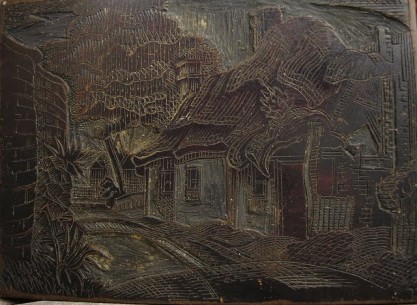As purveyors of collectible illustrative works, we are often asked time and time again, “what is a lithograph?” It’s a printing process that you’ve probably encountered more times than you’re aware of. You see it heralded in museums as 18th and 19th century pieces of fine art. It was the covers of the magazines in your grandma’s attic and the pin up calendars hanging in your grandpa’s garage. It was the high-tech mode for mass reproduction of its day. Before the digitization of mass media, there was lithography. But what is it? How does it work? And why is it important?
Lithography, Greek for stone printing, was invented by a Bavarian named Aloys Senefelder who was seeking a way to reproduce his own works. After several different attempts, he found that writing on a stone plate with a grease pencil made an easy way to repeatedly transfer images and text. This printing from a flat surface became known as planographic printing.

A more modern and streamlined form of lithography hit the United States in the mid 1800’s and allowed for more technical perfection and realistic imagery. Known as chromolithography, it utilized a rotary process that allowed it to be much faster than the flatbed presses that had been in use prior. Now everyone could have images printed; art reproduction, advertisements, graphics, and anything else customers could imagine. Soon, lithography firms were popping up all over the U.S.
It’s impossible to discuss illustration art without discussing lithography. The nostalgic depictions of hearth and home seen on the covers of magazines like the Saturday Evening Post and idealized girl-next-door pin ups whose visages graced the walls of homes, dorms, barricks, and garages across the country, were all produced via lithography.

Improvements in the technical production of lithographs continued to emerge in the 20th century. Offset printing in particular made faithful reproductions easy to create for a mass market. The basic process of offset lithography involved ink applied to an image that had been drawn on a stone was picked up by a nonabsorbent cardboard impression cylinder. It would then be immediately offset onto the printing surface. Though the basic process was known, companies were constantly tweaking and altering their processes. Always striving to perfection and to out-do their competitors, these companies held the specifics of their techniques in high secrecy. Like the KFC secret recipe of the printing world.

The 1920’s – 1960’s saw mass mainstream lithographic printing at it’s height. Most popular were calendar companies pumping out endless prints of seductive, cute, and clumsy pin up beauties. Pin up would take the media world by storm and it would all be thanks to the quick reproduction speeds of lithography. Calendar companies such as Brown & Bigelow and Louis F. Dow would develop a dedication to quality and impeccable service attracted the nation’s top illustrators including Maxfield Parrish, Gil Elvgren, and Rolf Armstrong. Home to the Brown & Bigelow and Louis F Dow calendar companies, the Twin Cities were the site of these two giants ever escalating fight to hire and retain the hottest illustrators.
To learn more about the untold story of the Dow/Bigelow fight, visit Grapefruit Moon Gallery at the 15th Annual Twin Cities 20th Century Art and Design Show being held at the Progress Center Building at the Minnesota State Fair on Saturday, September 20th. At the show, Sarahjane Blum-Murphy, co-owner of Grapefruit Moon Gallery will discuss these companies hyper competition for the calendar market. Along with the original artworks will be printed examples of the calendars, illuminating the significance the technical choices these two commercial lithography companies made would come to have on their fortunes.

